Yes, we know how it feels when people click the unsubscribe link in your email and disappear from your mailing list. Even though it may seem to be a disappointing turn of events, it is actually a healthy process necessary for running successful email campaigns. Feeling confused? Then, read on.
The benefits of an email unsubscribe link
When we talk about email subscribers, the “more is better” principle is a common myth in email marketing. You should focus not on the number of users on your mailing list but on its quality, and by quality we mean engagement. As an email marketer, you don’t get any benefits from people who are simply “ghosts’’ in in your mailing list and keep ignoring your emails.
When people voluntarily unsubscribe, it helps you
According to statistics, users both unsubscribe and mark emails as spam for the same reasons — irrelevant or too frequent emails, no interest in the brand, emails sent without permission.
One of the reasons for spam complaints is that people have a hard time trying to find an unsubscribe link and simply click “spam” instead. That’s a big problem for a senders, unlike unsubscribes, spam complaints do ruin sender reputation. That’s why you should work on making your unsubscribe button visible and simplify the opt-out process overall. But first, you need to know what laws stand behind the necessity to add the unsubscribe link to emails.
Laws behind the unsubscribe link
The requirement to place the unsubscribe link in every email is regulated by email spam laws set in different countries around the world, for example:
Let’s take a closer look at two of them.
The CAN-SPAM Act regulates “commercial electronic messages” and protects users from receiving spam. Some of the main requirements of the Act related to the unsubscribe process are the following:
- every commercial or marketing email must have the option to unsubscribe, including a clear explanation of how to do it;
- any opt-out request should be dealt with within ten business days;
- once an email address is unsubscribed, it can’t be sold or transferred.
The GDPR includes rules on personal data protection aimed to control users’ personal information. The Regulation establishes lawfulness, fairness, and transparency as the key principles for personal data processing, including the data erasure right of the user. For email marketing, it means deleting the subscriber’s data from all mailing lists, the process which a direct unsubscribe link can speed up.
Tips on adding the unsubscribe link to an email
Comply with the law and take care of your subscribers when it comes to providing them with a choice of either staying or leaving your mailing list. Do your best to make the opt-out process as fast and simple as possible following some simple recommendations.
Add an easy-to-find unsubscribe link to every email
It’s better to place an unsubscribe button in a visible place, where subscribers are used to looking for it — in the email footer, for example.
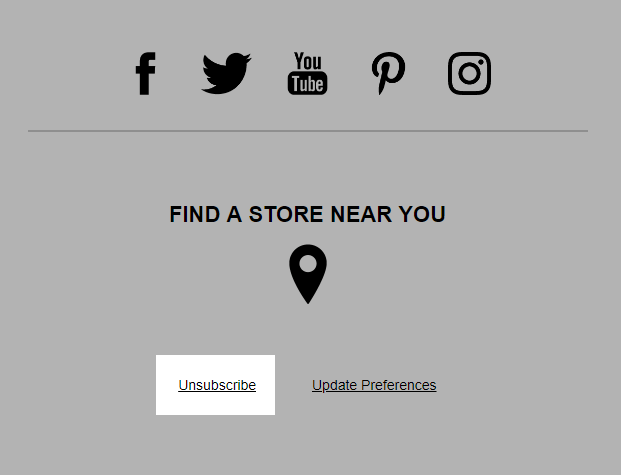 Unsubscribe link in the footer of an email from The North Face
Unsubscribe link in the footer of an email from The North Face
Here the link is easy to find thanks to the neat footer layout.
However, if you want to make sure that it is impossible to miss your unsubscribe link, you can place it right in the header like Office do in their emails:
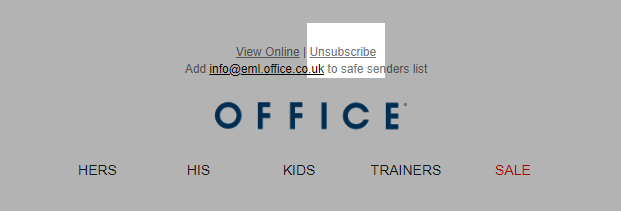 Unsubscribe link in the header of an email from Office
Unsubscribe link in the header of an email from Office
And here is an example of a badly placed email unsubscribe link:
 Almost invisible email unsubscribe link
Almost invisible email unsubscribe link
In fact, there is an option to unsubscribe from this email, but the text is placed on the background of nearly the same color, which makes it hardly visible. Moreover, there is even no sign that it is a clickable element — traditional underlining or blue color.
One more unsubscribe practice to avoid is surrounding the unsubscribe link with tons of text, which will make it almost impossible to find when quickly scanning through the text.
Simplify unsubscription
Unsubscribing should be easy: make it take just a couple of intuitive clicks. For instance, to unsubscribe from Michael Kors emails, you need only two clicks and one tick.
The first click goes to the unsubscribe link in the email.
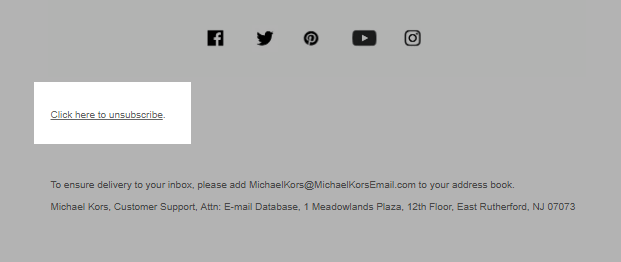 The first step of opting out of receiving emails from Michael Kors
The first step of opting out of receiving emails from Michael Kors
And the second one is the unsubscribe button in the notification opened in the browser. Plus a tick in the box.
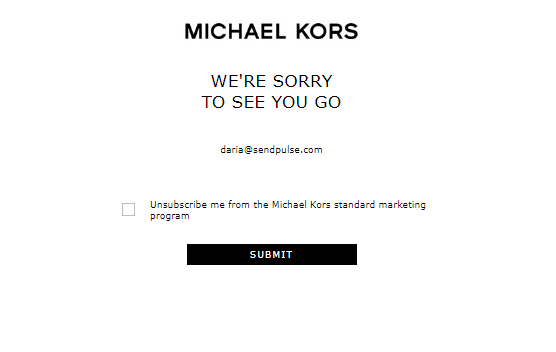 The second step of opting out of receiving emails from Michael Kors
The second step of opting out of receiving emails from Michael Kors
After that, a user sees the unsubscription confirmation message in their browser. Note that on the final unsubscribe page, Michael Kors offer ex-subscribers to switch to following the brand on social media instead of just letting them go.
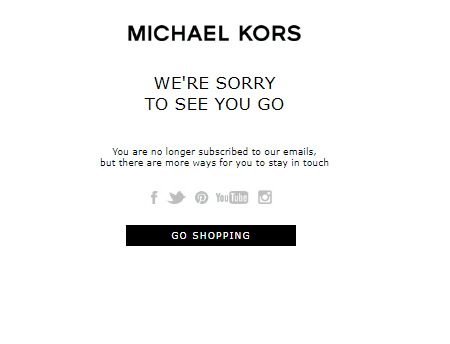 Unsubscription confirmation message from Michael Kors
Unsubscription confirmation message from Michael Kors
Owler made the unsubscription process even shorter. After following the unsubscribe link in any Owler email, a user gets transferred to the page with the confirmation message right away.
 Owler unsubscription confirmation message
Owler unsubscription confirmation message
A mistake that is better to avoid is asking users to enter their email address or log into their account after they’ve clicked the unsubscribe link.
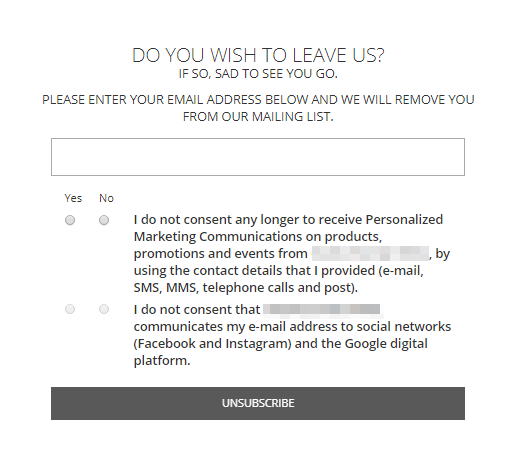 Email address request instead of the unsubscription confirmation message
Email address request instead of the unsubscription confirmation message
Respect your audience
Offer your subscribers a chance to opt-down and let them control the amount or types of emails they receive from you.
For example, when users opt-out from the Grammarly emails, they see a page which combines the email preferences and the unsubscription.
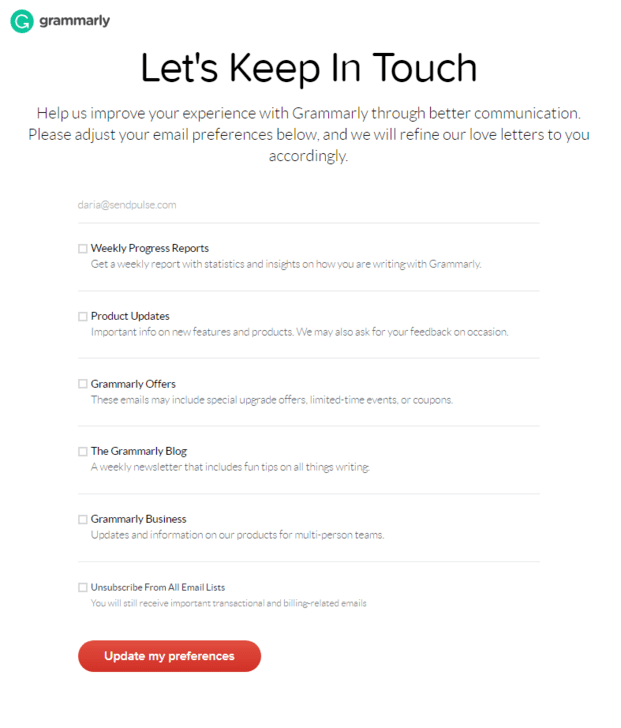 Unsubscription page from Grammarly
Unsubscription page from Grammarly
This option can help you return a subscriber who decided to leave a mailing list because they don’t know about any possibility to manage their preferences. In case the user chooses to go anyway, they can tick a corresponding box — no extra time or efforts needed, subscriber’s will respected.
Learn from your experience
It’s helpful to follow the reasons why users unsubscribe by simply asking them about it. Later, you can use this data to decrease the unsubscription rate and send your audience more relevant and more timely content.
For instance, Nature Baby allows users to choose from four options or write their own reason for the unsubscription. Still, it is not obligatory as the user has already unsubscribed successfully.
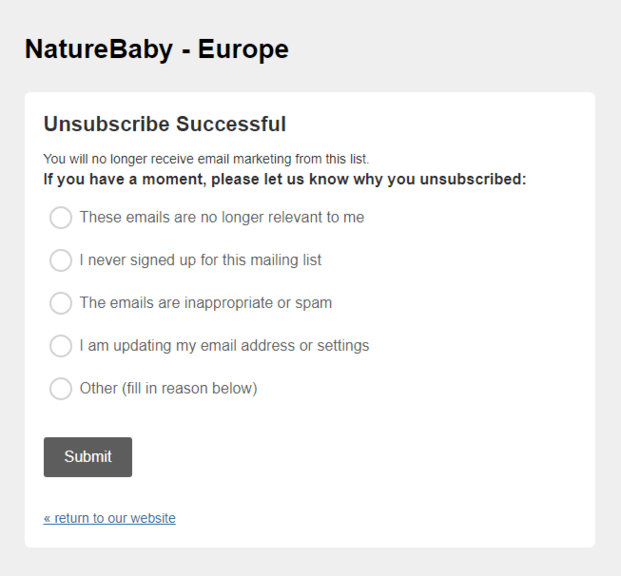 Unsubscription confirmation page with a short survey from Nature Baby
Unsubscription confirmation page with a short survey from Nature Baby
Summing it up
Unsubscribes are necessary to keep a clean mailing list, good sender reputation, and high engagement rates. So, make the unsubscription process easy and fast, don’t forget to comply with the anti-spam laws, and use SendPulse to send your emails and automate your marketing.